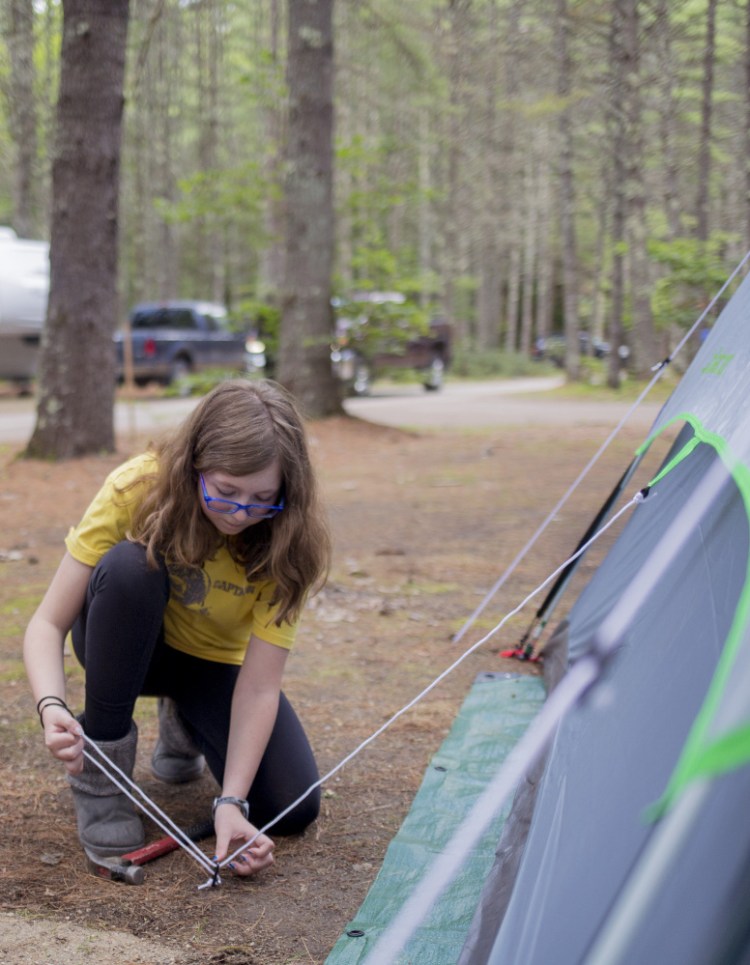CASCO — Camping in Maine has been growing in popularity. So if you’ve never been, it might be a good time to try.
Three of the past seven years had record numbers of campers at Maine state parks, according to the Maine Department of Agriculture, Conservation and Forestry. Last year set the all-time record with 254,798 camping at the 12 campgrounds.
Veteran campers at Maine’s largest state park campground – Sebago Lake – were asked to highlight the tricks to an easier, more relaxing camping experience. Talk to 30- and 40-year campers about why they sleep on the ground and eat in the woods, and you’re likely to hear many of the same things.
“My most happy memories are here,” said Kathy Darney of Thomaston, 47, who grew up camping at Sebago Lake.
Darney is not alone. The 264 sites at Sebago Lake Campground are normally 90-percent full in the summer midweek and booked solid on weekends, according to Park Manager Matt McGuire. Many come year after year.
Consider Michelle Ciak and her Connecticut clan. They have learned after 20 years of camping at Sebago the best way to stay dry: line up their four tents side by side and cover them with an enormous tarp, creating a veritable tent city.
“We call it the compound,” said Ciak of Middletown, Connecticut. “Every year we learn more things.”
Matt and Michelle Ciak have many tricks for making camping fun – like using a wedding-style pop-up tent for their “mess hall.” Michelle Ciak said the creativity involved is one reason they love kicking back outside.
TIP 1
Be prepared
Any veteran camper will tell you a successful camping trip comes from going in ready. As Darney said: “Once you’ve set up the tent and your bed, the rest of the time you can relax.”
Steve Mitchell from Rhode Island camped with his wife at Sebago for their honeymoon more than 18 years ago. And after a long hiatus from the beloved activity, he took his youngest daughter, Katelyn. But before leaving home he treated their new tent with a silicone-based spray to make it waterproof. And then he brought precooked meals – like spaghetti and meatballs – that could be warmed up in a frying pan.
“I’m not the cook in the family,” Mitchell said.
Nothing says you have to totally rough it.
TIP 2
The gear you need
Campers who have been at it for 30 to 40 years have bins full of gear they typically keep packed and ready for the next trip.

If cooking over an open campfire is not your thing, then you might need to light that propane camp stove to cook your meals.
“Those are dedicated bins,” Siak said with a wave toward four giant plastic bins. “Until we audit them and resupply.”
If this much organization intimidates you, fear not. There are just a handful of things you really need that, all told, can cost less than $150:
• A roof over your head. Hit a good sale and a two-person tent can be purchased for as little as $25, and with some waterproofing spray it can be enjoyed for decades. You can’t stand up in it, but the domes are great for reading and sleeping.
• A sound sleep. Mattress pads for camping sell for as little as $20 while air mattresses cost a bit more (between $20 and $100). Sleeping bags are the norm, but a first-timer can get away with some cotton sheets and a pillow thrown in a duffel bag.
• Meal time. The next must-have item is a cooler, which again can be found for under $20, although the bigger the cooler the more ice it can carry and the more home-cooked meals you can store and enjoy. Many say food is the best part of camping.
“Everything tastes better outside,” Mitchell said.
You’ll also need a covered bin for dishes and dry food, unless you want to share with the racoons.
• Get it hot. Many use propane camp stoves (around $50) or a jet-boil system ($50 to $100) to make hot water for freeze-dried food. Many fire pits will have a grate, or you can always bring one off the gas grill at home to be sure.
TIP 3
Make it like home
A walk around Sebago Lake Campground makes a few things clear: Most people have a screened tent over their picnic table and a tarp over the tents. But these are not necessary.
Other essentials include matches or a lighter for the campfire, beach chairs, a headlamp, and bug spray (although July through October actually is pretty bug-free in the Maine woods). All can be purchased for less than $50, although the better the gear, the longer it lasts.
Then there are the luxury items, like folding tables, solar lanterns, table cloths and party lights.
“I put lights over the coffee table every year,” said Linda Manchester of Casco, a camper for more than 30 years. “It’s my home away from home.”
TIP 4
A few resources
Maine is chock full of places to camp. Here are just a few ways to find them:
• Maine state park campgrounds: bit.ly/2tKhtUK
• Public Reserve Lands: bit.ly/2eOFcNc
• Maine’s private campgrounds: campmaine.com
And if you’re not ready to invest in gear, you can always rent. Here are a few outfits:
• Eastern Mountain Sports, Portland, 541-1919, and North Conway, New Hampshire, 603-356-5433.
• These retailers will mail rental gear: lowergear.com and outdoorsgeek.com, mountainsidegearrental.com.
Staff Writer Deirdre Fleming can be reached at 791-6452 or:
dfleming@pressherald.com
Twitter: FlemingPph
Send questions/comments to the editors.



